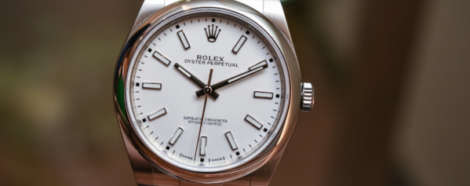VIDEO: The top Jaquet Droz watches from Basel 2018 (hint, there’s a lot of Grande Seconde in the mix)
 Just because Jaquet Droz is a relative newcomer to Australia doesn’t mean they don’t have history. The brand dates back to the mid-18th century, and, besides watches and clocks, is famous for their incredible automata. And while the incredibly complex, high-end art/engineering pieces are still important for the brand, we thought we’d keep it real and focus on their slightly more down-to-earth offerings from Baselworld 2018, offerings that focused heavily on their signature Grande Seconde model, with its oversized seconds subdial. And like any good signature model, the Grande Seconde is versatile. It excels at traditional — as evidenced by the black enamel moonphase model, and the yellow gold and grand feu Tribute — but can pivot nicely to contemporary, with the addition of a ceramic case or skeletonised treatment. Excellent stuff from a niche brand, with a strong and sophisticated identity.
Just because Jaquet Droz is a relative newcomer to Australia doesn’t mean they don’t have history. The brand dates back to the mid-18th century, and, besides watches and clocks, is famous for their incredible automata. And while the incredibly complex, high-end art/engineering pieces are still important for the brand, we thought we’d keep it real and focus on their slightly more down-to-earth offerings from Baselworld 2018, offerings that focused heavily on their signature Grande Seconde model, with its oversized seconds subdial. And like any good signature model, the Grande Seconde is versatile. It excels at traditional — as evidenced by the black enamel moonphase model, and the yellow gold and grand feu Tribute — but can pivot nicely to contemporary, with the addition of a ceramic case or skeletonised treatment. Excellent stuff from a niche brand, with a strong and sophisticated identity.
The post VIDEO: The top Jaquet Droz watches from Basel 2018 (hint, there’s a lot of Grande Seconde in the mix) appeared first on Time and Tide Watches.
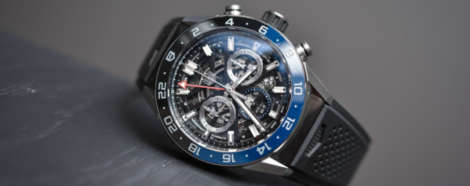
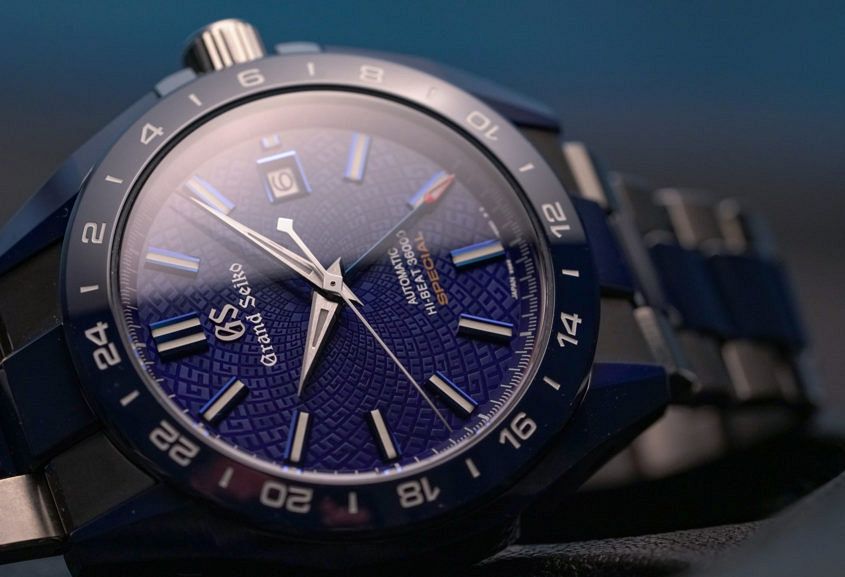 In the wonderful world of Grand Seiko, if it’s not using a quartz crystal – and, yes, that includes the Spring Drive – then inside is a Caliber 9S movement. Introduced in 1998, the Caliber 9S is the staple of all mechanical Grand Seikos and forms the base for everything from humble three-handers to hi-beats and GMTs. This year, Grand Seiko are celebrating the 20th birthday of the 9S with – in addition to quite a few other LEs – the release of the Grand Seiko Blue Ceramic Hi-Beat GMT “Special” Limited Edition. Vital statistics Inside is a very “special” version of the Caliber 9S86 movement. Adjusted to six positions and allowing for changes in temperature, the movement exceeds the already stringent accuracy tolerances set by Grand Seiko, and is accurate to within +4 to -2 seconds per day, while it still features the added functionality of a GMT hand, and runs at 10 beats per second for up to 55 hours. This particular version of the 9S86 is now kept running by an oscillating weight made from titanium and tungsten. Visible through a sapphire crystal case back, the titanium sections of the weight are treated with an anodic oxidation…
In the wonderful world of Grand Seiko, if it’s not using a quartz crystal – and, yes, that includes the Spring Drive – then inside is a Caliber 9S movement. Introduced in 1998, the Caliber 9S is the staple of all mechanical Grand Seikos and forms the base for everything from humble three-handers to hi-beats and GMTs. This year, Grand Seiko are celebrating the 20th birthday of the 9S with – in addition to quite a few other LEs – the release of the Grand Seiko Blue Ceramic Hi-Beat GMT “Special” Limited Edition. Vital statistics Inside is a very “special” version of the Caliber 9S86 movement. Adjusted to six positions and allowing for changes in temperature, the movement exceeds the already stringent accuracy tolerances set by Grand Seiko, and is accurate to within +4 to -2 seconds per day, while it still features the added functionality of a GMT hand, and runs at 10 beats per second for up to 55 hours. This particular version of the 9S86 is now kept running by an oscillating weight made from titanium and tungsten. Visible through a sapphire crystal case back, the titanium sections of the weight are treated with an anodic oxidation…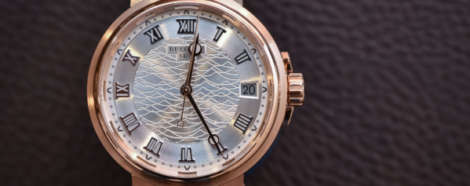
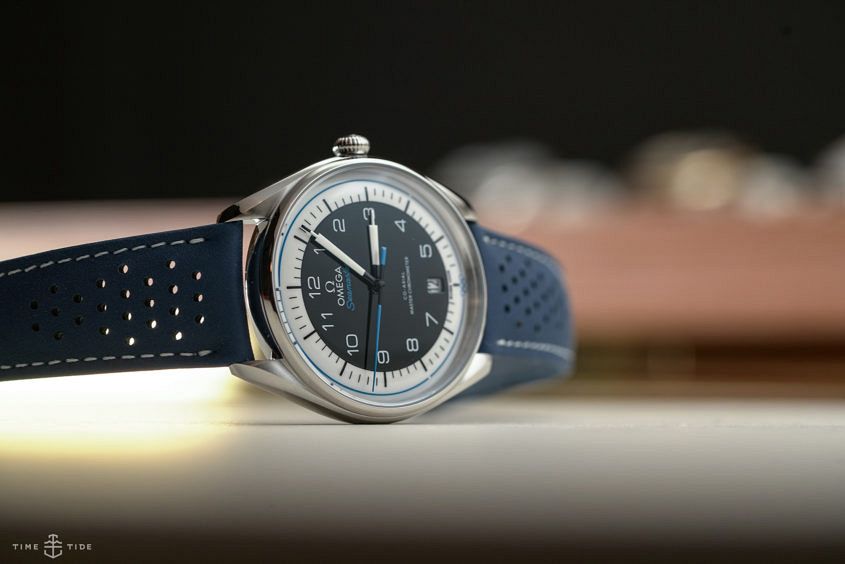 Though technically introduced ahead of Baselworld 2018, the fair provided the first opportunity to take a first-hand look at the latest Omega watch collection for the 2018 Olympics, and to be perfectly frank, I was more than impressed. More oft than not, Omega’s releases tied to the Olympic Games can be quite hit-and-miss. Case in point, the Mark II Speedmaster launched for Rio in 2016 was a home run, whereas the white dial Seamaster for the Vancouver 2010 Games (with a cherry-red bezel) was a bit lacklustre. This year, a collection of five dressy vintage-inspired Seamaster watches (one in each of the ring colours) have been unveiled, taking design cues from an Omega stopwatch created for the 1976 Montreal Games, which in press imagery looked like a real winner. Here’s what you need to know. Vital statistics Right out of the gates, there’s a lot to love about these new Seamaster models. Powered by the Co-Axial Master Chronometer certified Calibre 8800, you’re getting top-spec Omega. A 55-hour power reserve, silicon balance spring, and magnetic resistance up to 15,000 Gauss. Shy of the small Olympic rings at six o’clock (below the date), these pieces certainly don’t scream “Olympic edition” but rather…
Though technically introduced ahead of Baselworld 2018, the fair provided the first opportunity to take a first-hand look at the latest Omega watch collection for the 2018 Olympics, and to be perfectly frank, I was more than impressed. More oft than not, Omega’s releases tied to the Olympic Games can be quite hit-and-miss. Case in point, the Mark II Speedmaster launched for Rio in 2016 was a home run, whereas the white dial Seamaster for the Vancouver 2010 Games (with a cherry-red bezel) was a bit lacklustre. This year, a collection of five dressy vintage-inspired Seamaster watches (one in each of the ring colours) have been unveiled, taking design cues from an Omega stopwatch created for the 1976 Montreal Games, which in press imagery looked like a real winner. Here’s what you need to know. Vital statistics Right out of the gates, there’s a lot to love about these new Seamaster models. Powered by the Co-Axial Master Chronometer certified Calibre 8800, you’re getting top-spec Omega. A 55-hour power reserve, silicon balance spring, and magnetic resistance up to 15,000 Gauss. Shy of the small Olympic rings at six o’clock (below the date), these pieces certainly don’t scream “Olympic edition” but rather… When Raymond Weil designed the Calibre RW1212, their first ever in-house design (produced by Sellita), I suspect part of the mandate was to show it off, hence the open escapement prominently on display — literally showing off a movement they’re rightfully proud of. Well, Raymond Weil doubled down at Basel 2018, exposing not just the escapement but the whole dial, thanks to a new series of skeletonised Freelancers. As you’d expect, there’s a range of new offerings on the table, but the one that impressed us was this modern sporty number, with what remains of the dial done in crisp white, with contrasting blue hands and hour markers, with their appealing, slightly bulbous shape. It’s also worth noting that both hands and hours are lumed — a nice, useful addition. But really, the dial is dominated by the, well, lack of dial. The open-worked dial really gives you a look behind the scenes, showing off not only the escapement but the power barrel at 12 (which could, in a pinch, be used as a very, very rough power reserve indicator), and the power train on the nine o’clock side. The crown gearing is partially obscured by the Raymond Weil branding, the…
When Raymond Weil designed the Calibre RW1212, their first ever in-house design (produced by Sellita), I suspect part of the mandate was to show it off, hence the open escapement prominently on display — literally showing off a movement they’re rightfully proud of. Well, Raymond Weil doubled down at Basel 2018, exposing not just the escapement but the whole dial, thanks to a new series of skeletonised Freelancers. As you’d expect, there’s a range of new offerings on the table, but the one that impressed us was this modern sporty number, with what remains of the dial done in crisp white, with contrasting blue hands and hour markers, with their appealing, slightly bulbous shape. It’s also worth noting that both hands and hours are lumed — a nice, useful addition. But really, the dial is dominated by the, well, lack of dial. The open-worked dial really gives you a look behind the scenes, showing off not only the escapement but the power barrel at 12 (which could, in a pinch, be used as a very, very rough power reserve indicator), and the power train on the nine o’clock side. The crown gearing is partially obscured by the Raymond Weil branding, the… The dust of Baselworld 2018 has finally settled, and while there was a ton of quick news to hammer through, there are certain topics that require a little more digestion. Case in point: the world of small independent watchmaking had a lot on offer this year, both outlandish and understated. Having seen and handled innumerable watches during the duration of the fair, sifting through the archives to come to a decision on who led the pack required both patience and a healthy dose of decompression. Of course, there were some obvious frontrunners from the likes of H. Moser, Angelus, and something truly bonkers from Urwerk; however, there were a healthy number of releases both conservative and outlandish from all over this category. Sarpaneva Moonment Many of us in the industry have had a soft spot for Stepan Sarpaneva’s wild creations, but in 2018 he has upped the game by launching his first ever in-house caliber. The hand-wound caliber is partially exposed beneath Sarpaneva’s trademark cage-style dial, and features a unique interpretation of the brand’s iconic moonphase complication. Using vertically stacked optic fibre, and a solid rotating moonphase disc, the moonphase has a fascinating eclipse-like appearance that changes dramatically depending on…
The dust of Baselworld 2018 has finally settled, and while there was a ton of quick news to hammer through, there are certain topics that require a little more digestion. Case in point: the world of small independent watchmaking had a lot on offer this year, both outlandish and understated. Having seen and handled innumerable watches during the duration of the fair, sifting through the archives to come to a decision on who led the pack required both patience and a healthy dose of decompression. Of course, there were some obvious frontrunners from the likes of H. Moser, Angelus, and something truly bonkers from Urwerk; however, there were a healthy number of releases both conservative and outlandish from all over this category. Sarpaneva Moonment Many of us in the industry have had a soft spot for Stepan Sarpaneva’s wild creations, but in 2018 he has upped the game by launching his first ever in-house caliber. The hand-wound caliber is partially exposed beneath Sarpaneva’s trademark cage-style dial, and features a unique interpretation of the brand’s iconic moonphase complication. Using vertically stacked optic fibre, and a solid rotating moonphase disc, the moonphase has a fascinating eclipse-like appearance that changes dramatically depending on…
 The story in a second: Two stripes are all it takes to amp up the legacy and motorsports heritage of the Monaco. I’m willing to put the success of the Monaco down to two things. The Steve McQueen link, and the square shape. I’m sure there are numerous other factors, like the Calibre 11, at play. But really, it’s the fact that this watch is so distinctive, and was worn by someone so cool that the Monaco has stayed strong throughout the decades. The latest brightly striped Gulf Special Edition takes both these factors to the next level. The dial Typically with in-depth reviews I start with the case, as it provides the foundational framework of the watch. But today I’m going with the dial, because this watch is all about the dial, and not just because of those stripes. The square Monaco dial is already pretty distinctive, due to its shape and those matching, rounded-off registers. This version takes as a base the blue starburst finish of the Cal. 12, and the dial layout (horizontal indices FTW) of the heritage, Heuer-only model. Of course you might not notice that the first few times you look at it, as overlaid…
The story in a second: Two stripes are all it takes to amp up the legacy and motorsports heritage of the Monaco. I’m willing to put the success of the Monaco down to two things. The Steve McQueen link, and the square shape. I’m sure there are numerous other factors, like the Calibre 11, at play. But really, it’s the fact that this watch is so distinctive, and was worn by someone so cool that the Monaco has stayed strong throughout the decades. The latest brightly striped Gulf Special Edition takes both these factors to the next level. The dial Typically with in-depth reviews I start with the case, as it provides the foundational framework of the watch. But today I’m going with the dial, because this watch is all about the dial, and not just because of those stripes. The square Monaco dial is already pretty distinctive, due to its shape and those matching, rounded-off registers. This version takes as a base the blue starburst finish of the Cal. 12, and the dial layout (horizontal indices FTW) of the heritage, Heuer-only model. Of course you might not notice that the first few times you look at it, as overlaid…